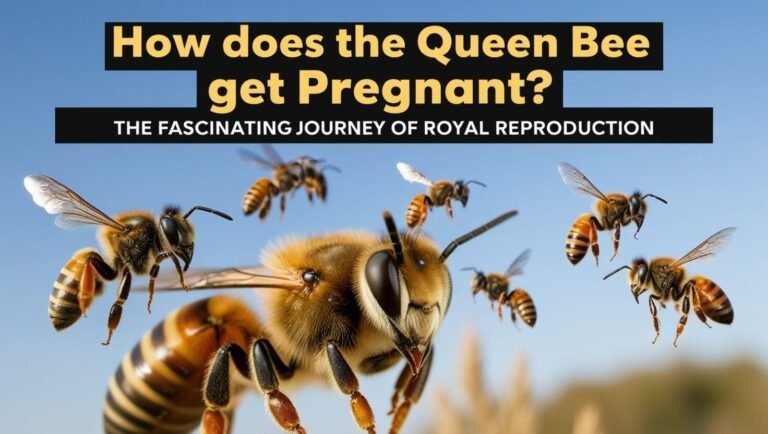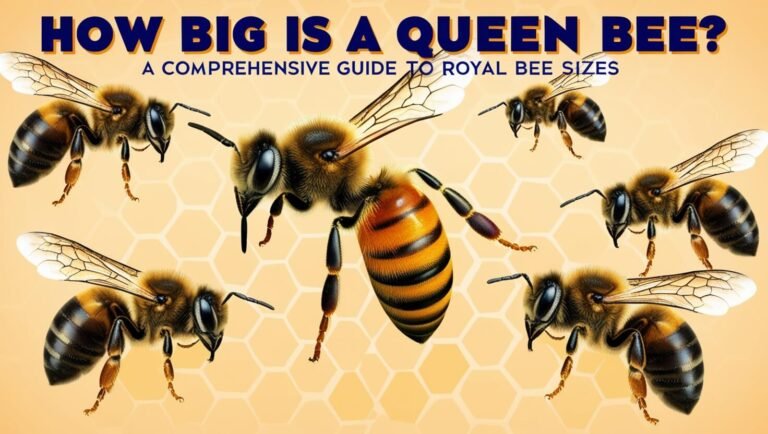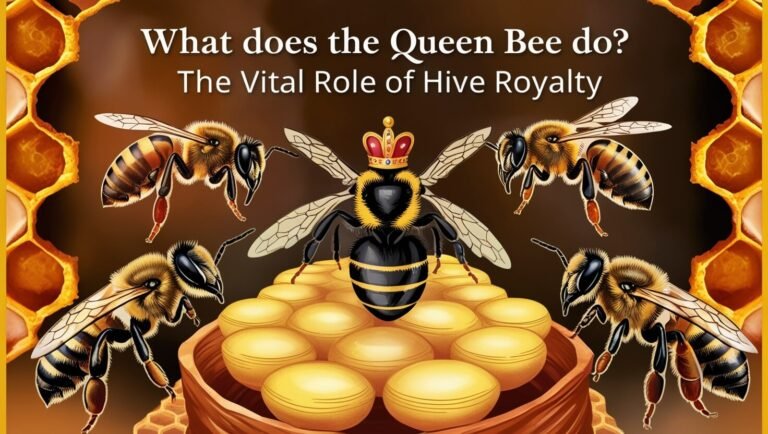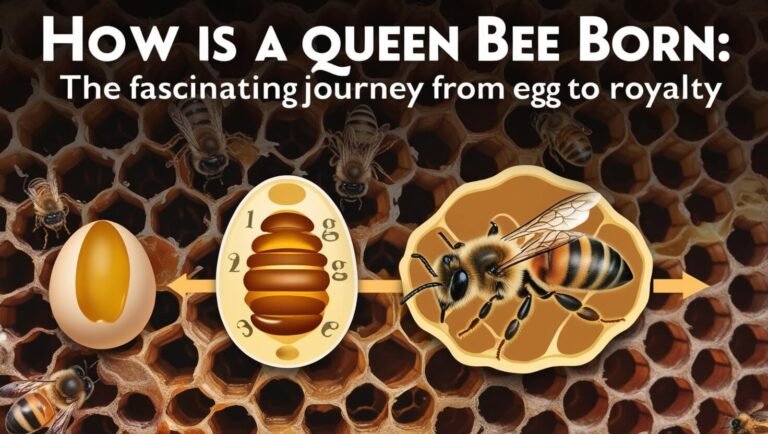How Is a Queen Bee Chosen? The Fascinating Process Behind Bee Royalty
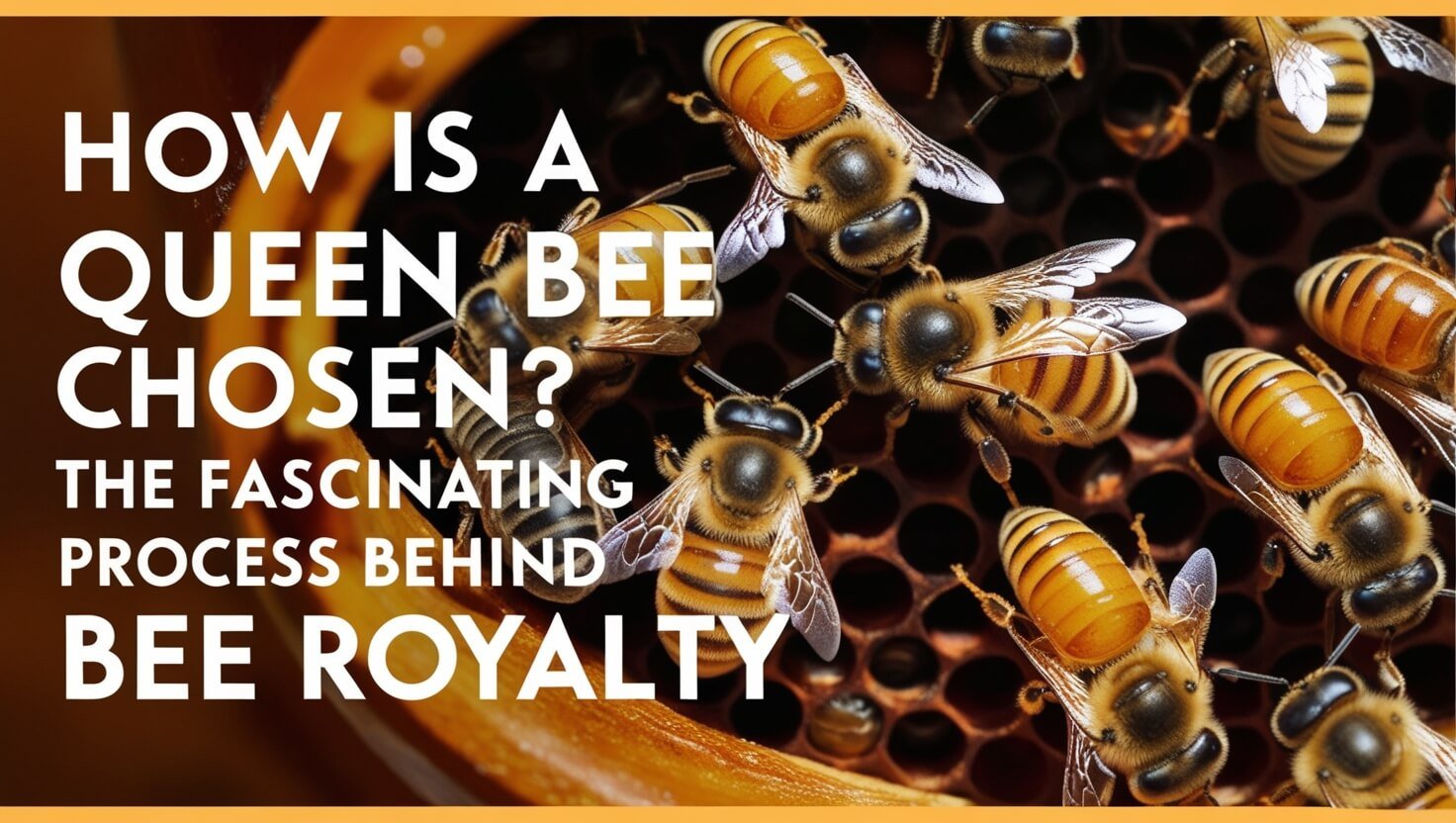
The selection of a queen bee is a remarkable process that combines instinct, biology, and a touch of magic within the beehive. This intricate journey from egg to royalty is crucial for the survival and prosperity of honey bee colonies. In this comprehensive guide, we’ll explore the fascinating world of queen bees, uncovering the secrets behind their selection and the pivotal role they play in the hive’s ecosystem.
The Importance of the Queen Bee in a Hive
At the heart of every thriving honey bee colony lies a single, vital individual: the queen bee. Her presence is so crucial that the entire social structure and productivity of the hive revolve around her.
The Queen’s Role in Colony Survival
The queen bee is more than just a figurehead; she’s the lifeline of the entire colony. Her primary responsibility is reproduction, laying up to 2,000 eggs per day during peak season. This constant replenishment of the hive’s population ensures a steady workforce of worker bees and potential future queens.
Beyond reproduction, the queen also maintains colony cohesion through pheromones. These chemical signals influence the behavior of worker bees, keeping the hive organized and focused on their collective tasks. Without a queen’s pheromones, a colony can quickly fall into disarray, leading to decreased productivity and potential collapse.
Why Colonies Need to Replace Queens
Despite their importance, queen bees are not immortal. A typical queen can live for 2-5 years, but her egg-laying capacity often declines after the first couple of years. When this happens, or if the queen dies unexpectedly, the colony must act quickly to ensure its survival.
There are several scenarios where a colony might need to replace their queen:
- Natural death of the old queen
- Accidental death (e.g., during hive inspections)
- Decreased egg-laying capacity
- Genetic diversity needs
- Beekeeper-initiated requeening for hive management
The process of replacing a queen, whether initiated by the bees themselves or by a beekeeper, is a critical event in the life of a colony. It’s a testament to the remarkable adaptability and survival instincts of honey bees.
The Life Cycle of a Honey Bee
To understand how a queen is chosen, it’s essential to first grasp the basics of bee development. The journey from egg to adult is a fascinating process that differs slightly depending on whether the bee is destined to become a worker, a drone, or a queen.
From Egg to Adult: Stages of Bee Development
The life cycle of a honey bee consists of four main stages:
- Egg: The queen lays a single egg in each cell of the honeycomb. These tiny, rice-shaped eggs are barely visible to the naked eye.
- Larva: After about three days, the egg hatches into a larva. This small, white, worm-like creature is fed constantly by nurse bees.
- Pupa: Around day 9 or 10, the larva spins a cocoon and enters the pupal stage. During this time, the bee undergoes metamorphosis, developing into its adult form.
- Adult: Finally, the fully formed bee emerges from its cell, ready to take on its role in the hive.
The entire process takes about 21 days for worker bees, 24 days for drones, and only 16 days for queens.
Differences Between Worker, Drone, and Queen Bees
While all bees start as identical eggs, their development paths diverge based on their future roles:
- Worker Bees: These females make up the majority of the hive. They are fed a mixture of pollen and nectar throughout their larval stage.
- Drone Bees: The males of the colony, drones are raised in slightly larger cells and fed similarly to worker bees.
- Queen Bees: Future queens receive special treatment from the very beginning, setting them on a unique developmental path.
The key difference lies in how potential queens are fed and cared for, which brings us to the fascinating process of queen rearing.
The Royal Treatment: How Worker Bees Create a Queen
The creation of a new queen is one of the most remarkable processes in the natural world. It’s a testament to the collective intelligence of the hive and the incredible plasticity of bee biology.
Selection of Larvae for Queen Rearing
When a colony needs a new queen, worker bees select several young female larvae, typically less than three days old. These chosen few are destined for a royal future. The selection process is critical, as only the youngest larvae can fully develop into viable queens.
Workers seem to prefer larvae from eggs laid in special elongated cells called queen cups, which are scattered throughout the hive. However, in emergencies, they can select larvae from regular worker cells as well.
The Magic of Royal Jelly
The secret ingredient in queen development is a substance called royal jelly. This nutrient-rich secretion is produced by young worker bees and is fed to all larvae in the hive for the first few days of their lives. However, queen larvae are fed royal jelly exclusively and in much larger quantities throughout their development.
Royal jelly is a complex mixture of proteins, sugars, fats, and other compounds. Its exact composition is still not fully understood, but it’s known to contain hormones and other bioactive substances that trigger queen development.
The difference in diet between worker larvae and queen larvae is stark:
- Worker larvae receive royal jelly for only their first three days, after which their diet switches to a mixture of pollen and nectar (bee bread).
- Queen larvae are lavished with royal jelly throughout their entire larval stage, receiving up to 1,600 times more of this precious substance.
This exclusive royal jelly diet is what enables a female larva to develop into a fertile queen rather than a sterile worker.
Queen Cell Construction
As the selected larvae grow, worker bees construct special queen cells around them. These cells are distinctly different from the hexagonal cells used for raising workers and drones:
- They’re larger, typically about 2.5 cm long.
- They hang vertically from the comb, resembling peanut shells.
- The opening faces downward, unlike horizontal worker cells.
Workers continually expand these cells as the queen larvae grow, ensuring they have ample space to develop. They also carefully regulate the temperature and humidity within the cells to provide optimal conditions for queen development.
The construction and care of queen cells require significant resources from the colony, underscoring the importance of the queen to the hive’s future.
The Science Behind Queen Bee Development
While the process of queen bee creation might seem magical, it’s rooted in fascinating scientific principles. Recent research has shed light on the genetic and epigenetic factors that contribute to the development of a queen bee.
Genetic Factors in Queen Selection
All female bees (workers and queens) share the same genes. What differentiates a queen from a worker is not the genes themselves, but how these genes are expressed. This is where the concept of epigenetics comes into play.
However, genetic factors do play a role in determining which larvae are selected for queen rearing. Studies have shown that certain genetic lines are more likely to be chosen for queen development, possibly due to factors like pheromone production or other subtle cues that worker bees can detect.
Epigenetics and Queen Bee Creation
Epigenetics refers to changes in gene expression that don’t involve alterations to the DNA sequence itself. In the case of queen bees, the royal jelly diet triggers epigenetic changes that activate queen-specific genes and suppress worker-specific ones.
Key epigenetic mechanisms involved in queen development include:
- DNA methylation: This process can turn genes on or off. In queen larvae, certain genes are demethylated, allowing for their expression.
- Histone modification: Changes to histone proteins can affect how tightly DNA is packed, influencing gene accessibility.
- microRNA regulation: Small RNA molecules can fine-tune gene expression, playing a role in caste determination.
These epigenetic changes, triggered by the royal jelly diet, lead to the development of queen-specific traits such as enlarged ovaries, the ability to produce queen pheromones, and a larger body size.
The Role of Proteins in Queen Development
Royal jelly contains several proteins that are crucial for queen development. One of the most important is royalactin, which was identified in 2011. This protein activates pathways that lead to:
- Increased body size
- Faster development
- Fully developed ovaries
Other proteins in royal jelly have been found to have antimicrobial properties, helping to protect the developing queen from diseases.
The interplay between these proteins, the larva’s genome, and epigenetic factors results in the transformation of an ordinary female larva into a queen bee. This process is a testament to the complexity and adaptability of bee biology.
The Queen’s Emergence and Rivalry
As the queen larvae develop in their specially constructed cells, the hive prepares for a dramatic event: the emergence of new queens and the potential battle for supremacy that follows.
The Virgin Queen’s First Days
After about 16 days of development, a new virgin queen is ready to emerge from her cell. Using her strong mandibles, she chews through the wax cap of her cell and emerges into the hive.
The first few days of a virgin queen’s life are critical and fraught with danger. Her initial priorities are:
- Strengthening her body: The queen spends her first day or two stretching her wings and hardening her exoskeleton.
- Becoming familiar with the hive: She explores her new domain, learning the layout of the colony.
- Avoiding rivals: If other queen cells are present, she may seek them out to eliminate potential competitors.
During this time, the virgin queen is not yet producing the full complement of queen pheromones, so worker bees may initially treat her with some aggression or indifference.
Battle for the Throne: Queen Fights
In many cases, especially during natural queen succession or swarming events, multiple queen cells may be present in the hive. This sets the stage for one of nature’s most dramatic conflicts: the battle between rival queens.
When two virgin queens encounter each other, they engage in a fierce fight to the death. These battles are characterized by:
- Aggressive posturing and antennae touching
- Attempts to sting each other
- Wrestling and biting
The fight usually ends quickly, with one queen fatally stinging the other. The victor then turns her attention to any remaining queen cells, using her sting to eliminate unhatched rivals through the wax walls of their cells.
This brutal process ensures that only one queen survives to lead the colony. It’s nature’s way of selecting the strongest and most viable queen to carry on the genetic line of the hive.
In some cases, if the colony is preparing to swarm, worker bees may intervene to prevent queens from fighting, allowing multiple queens to coexist temporarily. However, this is a rare exception to the “one hive, one queen” rule.
The Mating Flight and Colony Acceptance
Once a virgin queen has emerged victorious from any rivalries, her next crucial task is to mate and begin her egg-laying duties. This process involves a remarkable feat of nature known as the nuptial flight.
The Queen’s Nuptial Flight
Approximately 5-10 days after emerging from her cell, the virgin queen embarks on her mating flight. This event is critical for the future of the colony, as it’s the only time in her life that the queen will mate.
The nuptial flight typically occurs on a warm, calm day and involves several fascinating aspects:
- Preparation: The queen orients herself to the hive’s location, flying in ever-widening circles to memorize landmarks.
- Pheromone release: She releases a powerful pheromone to attract male drones from other colonies.
- Drone congregation areas: The queen flies to special areas where drones gather, sometimes up to 200 feet in the air.
- Multiple matings: Over the course of one or more flights, the queen mates with 12-20 drones.
- Sperm storage: The queen stores the sperm from these matings in her spermatheca, a special organ that will allow her to fertilize eggs for years to come.
This process of polyandry (mating with multiple males) ensures genetic diversity within the colony, which is crucial for hive health and adaptability.
How Worker Bees Accept Their New Queen
Upon returning from her mating flight, the new queen faces another challenge: gaining acceptance from the worker bees. This process is facilitated by pheromones and behavior:
- Pheromone production: After mating, the queen begins producing a full complement of queen pheromones, which help to organize and unify the colony.
- Egg-laying: The queen typically starts laying eggs within a few days of her return, which is a strong signal to the workers of her fertility and value.
- Worker behavior: Workers form a “retinue” around the queen, feeding and grooming her, and spreading her pheromones throughout the hive.
- Pheromone distribution: Workers who have been in contact with the queen spread her pheromones to other bees through food sharing and physical contact.
If the queen is accepted, the colony will rally around her, and normal hive activities will resume or intensify. However, if the workers reject the queen (which can happen if she’s deemed inadequate or if she fails to mate successfully), they may kill her and start the process of raising a new queen all over again.
The acceptance of a new queen is a critical moment in the life of a colony. It represents the beginning of a new era and sets the stage for the hive’s future success.
Beekeeper’s Role in Queen Selection
While the natural process of queen selection is fascinating, beekeepers often play an active role in queen rearing and selection. This intervention can help maintain healthy, productive hives and even improve the genetic stock of honey bees.
Artificial Queen Rearing Techniques
Beekeepers have developed several methods to rear queens artificially, allowing for more control over the process and the ability to produce multiple queens simultaneously. Some common techniques include:
- Grafting method: This involves transferring young larvae into artificial queen cups. The larvae are then placed in a queenless colony or a special queen-rearing nucleus to be raised as queens.
- Jenter kit: This system allows queens to lay eggs directly into removable cell cups, eliminating the need for grafting.
- Miller method: In this technique, a comb is cut to encourage bees to build queen cells along the edge.
- Alley method: This involves cutting strips of comb containing eggs and attaching them to bars in a way that encourages queen cell construction.
These methods allow beekeepers to produce queens with desired traits, such as disease resistance, gentleness, or high honey production.
Introducing a New Queen to a Hive
Sometimes, beekeepers need to introduce a new queen to an existing colony. This might be necessary if the old queen has died, is failing, or if the beekeeper wants to improve the genetic stock of the hive. The process requires careful management:
- Queen cages: New queens are typically introduced in small cages that allow worker bees to become accustomed to her pheromones before she’s released.
- Candy plug: The cage is often sealed with a sugar candy plug that workers eat through, gradually releasing the queen.
- Monitoring: Beekeepers closely watch the hive’s acceptance of the new queen, looking for signs of aggression or rejection.
- Requeening timing: The introduction of a new queen is often timed with natural cycles in the hive, such as during a nectar flow when bees are less aggressive.
Successful introduction of a new queen requires patience and careful observation. It’s a delicate process that balances the bees’ natural instincts with the beekeeper’s management goals.
Challenges in Queen Bee Selection
The process of queen bee selection and development faces various challenges, both natural and human-induced. Understanding these challenges is crucial for beekeepers and conservationists working to maintain healthy bee populations.
Natural Threats to Queen Development
Several natural factors can interfere with successful queen development:
- Weather conditions: Extreme temperatures or high humidity can affect the development of queen larvae and the success of mating flights.
- Predators: Birds, dragonflies, and other insects may prey on queens during their mating flights.
- Diseases and parasites: Various pathogens can affect developing queens, including viruses, bacteria, and parasitic mites.
- Genetic factors: Inbreeding or poor genetic diversity can lead to less viable queens.
- Colony stress: Factors like food scarcity or overcrowding can impact the colony’s ability to raise healthy queens.
Human Impact on Queen Bee Selection
Human activities have introduced additional challenges to queen bee selection:
- Pesticide exposure: Neonicotinoids and other pesticides can affect queen development and fertility.
- Habitat loss: Urbanization and intensive agriculture reduce the diversity of food sources and nesting sites for bees.
- Climate change: Shifting weather patterns can disrupt the timing of queen rearing and mating flights.
- Artificial selection: While selective breeding can improve certain traits, it may also reduce genetic diversity if not managed carefully.
- Transportation stress: Commercial bee operations often move hives long distances, which can stress the colonies and affect queen health and development.
- Pollution: Air and water pollution can impact the overall health of bee colonies, including queen development.
- Electromagnetic radiation: Some studies suggest that electromagnetic fields from cell towers and other sources might interfere with bees’ navigation abilities, potentially affecting queen mating flights.
These challenges highlight the delicate balance between human activities and the natural processes of queen bee selection. Addressing these issues requires a multifaceted approach involving beekeepers, researchers, policymakers, and the general public.
The Future of Queen Bees
As our understanding of queen bee biology and the challenges they face grows, researchers and beekeepers are developing new strategies to support healthy queen development and selection. These efforts are crucial for the future of beekeeping and the broader ecosystem services that bees provide.
Research and Advancements in Queen Rearing
Ongoing research is shedding new light on queen bee biology and opening up new possibilities for queen rearing:
- Genetic mapping: Scientists are identifying genes associated with desirable traits, potentially allowing for more precise breeding programs.
- Improved nutrition: Research into the components of royal jelly and other bee nutrition could lead to better supplemental feeding for developing queens.
- Cryopreservation: Techniques for freezing bee semen are being developed, which could help preserve genetic diversity and allow for more controlled breeding.
- Automated monitoring: New technologies are being developed to monitor queen health and productivity in real-time, allowing for earlier intervention when problems arise.
- Pheromone research: Better understanding of queen pheromones could lead to improved methods for queen introduction and colony management.
Preserving Genetic Diversity in Queen Bees
Maintaining genetic diversity is crucial for the long-term health and adaptability of honey bee populations. Efforts in this area include:
- Conservation breeding programs: Initiatives to preserve and propagate diverse bee populations, including native and wild bees.
- Gene banks: Establishment of repositories for diverse bee genetic material, including frozen semen and eggs.
- International cooperation: Collaborative efforts to exchange genetic material and breeding stock between different regions.
- Promotion of natural mating: Encouraging practices that allow for more natural queen mating, rather than relying solely on artificial insemination.
- Education and outreach: Programs to inform beekeepers and the public about the importance of genetic diversity in bee populations.
These efforts aim to ensure that future generations of queen bees have the genetic tools to adapt to changing environments and resist new threats.
Wrapping UP: The Miraculous Journey of Becoming Queen
The process of how a queen bee is chosen is a testament to the complexity and wonder of nature. From the careful selection of larvae by worker bees to the epic battles between rival queens, every step of this journey is crucial for the survival and prosperity of the honey bee colony.
We’ve explored the intricate biology behind queen development, including the vital role of royal jelly and the fascinating epigenetic changes that transform an ordinary egg into royalty. We’ve seen how beekeepers can influence this process, working in harmony with the bees’ natural instincts to produce healthy, productive queens.
However, the challenges facing queen bees and honey bee populations in general are significant. From natural threats to human-induced pressures, the path to queendom is fraught with obstacles. Yet, through ongoing research, conservation efforts, and improved beekeeping practices, we are finding ways to support and protect these crucial insects.
The story of queen bee selection is more than just a fascinating biological process – it’s a reminder of the delicate balance in our ecosystems and the incredible adaptability of nature. As we continue to unravel the mysteries of the hive, we gain not only valuable scientific knowledge but also a deeper appreciation for the complex societies of these tiny yet vitally important creatures.
For beekeepers, researchers, and nature enthusiasts alike, the queen bee remains a symbol of resilience, adaptation, and the enduring magic of the natural world. By understanding and supporting the process of queen bee selection, we play a crucial role in ensuring the future of these remarkable insects and the vital services they provide to our planet.

